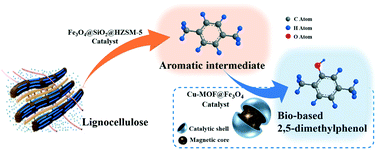High value utilization of biomass: selective catalytic transformation of lignocellulose into bio-based 2,5-dimethylphenol†
Abstract
High-value utilization of lignocellulosic biomass is of great significance to reduce carbon emission. The purpose of this work is to prove that 2,5-dimethylphenol, an important high value chemical, can be selectively prepared from renewable lignocellulose (especially cellulose and hemicellulose). This novel steerable transformation has been achieved by the catalytic pyrolysis of lignocellulose to p-xylene intermediate over a magnetic zeolite catalyst (Fe3O4@SiO2@HZSM-5) and the hydroxylation of an aromatic intermediate to 2,5-dimethylphenol over a magnetic metal–organic framework catalyst (Cu-MOF@Fe3O4). A high selectivity of 2,5-dimethylphenol (80.2%) with a high conversion (90.4%) was achieved using the Cu-MOF@Fe3O4 catalyst developed. To understand the reaction pathways, the key reaction intermediates (like OH radicals) were investigated. It was found that the valence state of copper ions in the Cu-MOF@Fe3O4 catalyst plays a pivotal role in the formation of OH radicals and the synthesis of 2,5-dimethylphenol. The current study may constitute an example for the directional synthesis of high value bio-chemicals according to the unique composition of lignocellulose.



 Please wait while we load your content...
Please wait while we load your content...